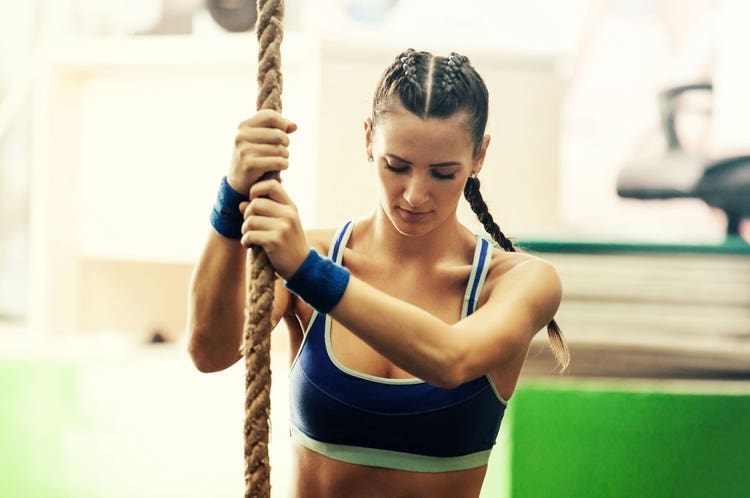The Art of Strength

Factor these six different types of strength into your fitness strategy.
By Sarah Casey, Institute of Motion
Strength is a funny trait. We definitely know it when we see it. But how to explain it? Think about the following groups: bodybuilders, yogis, acrobats, farmers. Which has the most strength?
The truth is, there are many different types of strength. And just as painters use more than one color to create a masterpiece, we need to cultivate all the various types of strength for a strong body.
Take this quiz to find out what strength type you need most right now, and discover how to develop it.
1. Maximal strength
What it is: Is this the first thing that comes to mind when you think of strength? Max strength lets us lift or move very heavy items for a short period of time, say, lifting furniture or moving a large rock in the garden. And though heavy lifting can earn you the nickname “meathead,” maximal strength relies on intelligent communication between the brain and the body. It’s hard to lift something very heavy while you talk to someone or when your kids are asking a million questions. When we use maximal strength, our body needs us to focus.
Building it: To build max strength, we need to lift heavy things. Think plate-loaded machines or power lifts (like squats and dead lifts). With heavy loads, it’s important to have strong form to stay safe. This is a great time to consult a personal trainer to coach you through proper form and safe increases in weight. If you’re starting out on your own, try this one-arm dead lift. Begin with lighter weight and build up slowly as you can lift more.
https://www.youtube.com/watch?v=hYdl4h5ueZw
2. Strength endurance
What it is: When we need to maintain a level of strength for a length of time, we need strength endurance. Think of climbing a hill on your bike or lugging your suitcase up a flight of stairs at the airport. When we improve strength endurance, these tasks get easier.
Building it: For endurance, we need longer sets with light to medium weights and low rest between sets. Try this lateral squat with same-side band hold. For endurance strength, we’re looking at 10–15 reps on one side and then another 10–15 on the other side. Repeat both sides 2–3 times without any rest in between if you can. Be sure to keep your arm stiff as you push the tubing away, but don’t lock your elbow!
https://www.youtube.com/watch?v=3rUhOVDuzJo
3. Starting strength
What it is: We use this type of strength to move ourselves or other things from a stationary position. If you watched last month’s Super Bowl, you saw starting strength in action during the wide receiver’s quick start. And if you watched from the couch at home, well, you used starting strength to jump up when your team made a great play. This also helps us move the sofa when we decide it works better on the other side of the room or haul the recycling bins outside on trash day.
Building it: Typically, we train for this on the track with sprints. Since that’s not always practical in the gym, we also use exercises that start on the ground and end in a standing position. Try this prone push-back ground-to-standing exercise. If you can relax at the end of each rep, then every new rep will need to overcome the stationary position (which is exactly what we’re after). Interestingly, most maximal strength drills also improve starting strength, so be sure to check out that section too.
https://www.youtube.com/watch?v=dAInxWxVz9M
4. Agile strength
What it is: Agile strength refers to the ability to start, stop and change direction quickly while overcoming an outside resistance or the momentum of a moving object. We use this during activities like carrying groceries into the house, playing with kids, waiting tables at a busy restaurant or fending off opponents in sports.
Building it: Agile strength improves when we challenge ourselves with multidirectional movement and different types of resistance. Holding a band or tubing away from the body as we move helps us learn to control outside resistance, while moving a weighted object improves our control of momentum. Give this split stance lateral lunge with opposite hold a try to improve whole-body coordination and agile strength.
https://www.youtube.com/watch?v=Tne1Mxmmn_c
5. Odd-position strength
What it is: We’ve all grabbed for something from the farthest corner of the lowest shelf in the kitchen or reached in a weird way to stash something in the highest part of the closet. The strength required to lift or move from a variety of different positions requires our body and brain to quickly work together to find a safe and effective way to accomplish the task.
Building it: In discussions of strength training, we hear about “ideal form.” While maximal lifts definitely require strict form for safety’s sake, being strong in less-than-ideal positions is also important for an active lifestyle and healthy aging. Embrace oddness with this split kneel rotational reverse dead lift. To maintain safety in these non-ideal positions, choose lighter weights and build up slowly.
https://www.youtube.com/watch?v=--AOIpNKggQ
6. Body-weight strength
What it is: This has to do with the amount of strength we have compared to our size, weight and environment. We need body weight strength for everyday tasks, such as climbing a ladder or a steep hill, and for fun, like dancing, trying handstands or practicing yoga.
Building it: Body weight strength relies on exceptional body awareness and control. Think about dancers or gymnasts—even when flying through the air, they are in total control. By moving as slowly as possible through this side kick-through, you’ll improve body weight strength as well as body awareness and control.
https://www.youtube.com/watch?v=3-CcmYDLrkE
Photo credit: 123RF, Dragan Grkic; video credit: Institute of Motion